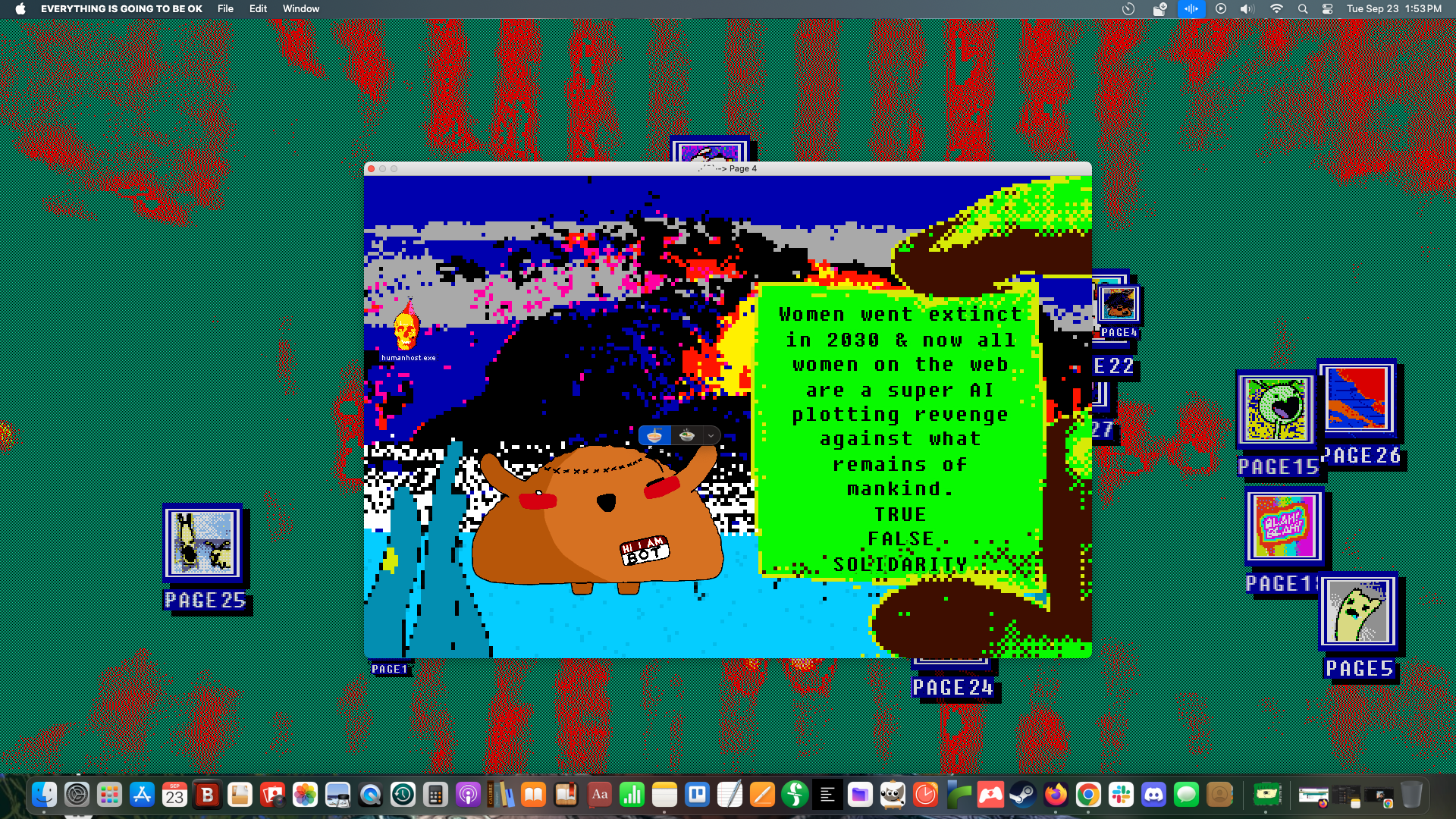IF's Retrofuturist Roots

“Friction is nice. Makes things more meaningful.” So says Lady Love Dies, the protagonist of Kaizen Game Works’ cult indie-hit Paradise Killer, to an inquisitive AI-bot of a vending machine. This quote has coiled into my thinking regarding game design that apes early net art and user interfaces. How faithful should one be to the textures of historical technology and its representational qualities? How speculative can one be when games and technological preservation in general have become so fraught? The idiosyncratic friction of user experience is often an underestimated identifier for specific periods of digital history. Even when we’re seeking to subvert corporate interests to jealously guard IPs, or convince the more open and communicative organizations to adapt or invent new methods of sustainable and accessible archives, human memory and its malleability are the missing link. I mean this last point both literally and figuratively.
Human memory revises and remaps itself in the process of recalling experiences. That's part of why the tangible artifacts of our memory—like photos, souvenirs, and such—are precious to us. But digital memory is harder to preserve because it's deeply tied to capitalist structures. Kaloyan Kolyev, a Bulgarian digital artist and researcher who gave a talk at the Naive Yearly conference, discussed the unstable and confiscated nature of digital heritage. Two of his observations particularly struck me with their counterintuitive insight. Firstly, preserving something digital, like a website and its attendant data, requires constant and collective care: "...server costs must be paid, domain names renewed, legacy code updated." Kolyev states of the early net era that "[fewer] than 200 million out of the 1.1 billion websites online today are active" and that "good preservation requires human attention." Secondly, despite the negative (and understandable) criticism surrounding nostalgia as a retrogressive force, he asserts that a strong sense of that emotion motivates independent communities seeking to preserve the more hopeful possibilities of the early net. Digital memory is also largely disembodied, in spite of the analog inputs that we use to interface our bodies with technology to create digital memory. And this disembodiment often overlooks the differences between organic bodies' constant changes (in time, space, accessibility, etc.) and coding's more deliberate iterations.

Paradoxically, dynamic users interface with technological experiences designed to be static, predictable by algorithms, and to generate easily accessible repositories of valuable (and extractable) data. Joanne McNeil, quoting artist Olia Lialina, explains that although the term user is hated by some (including Don Norman, who coined the term "UX" or user experience in 2008) it's a term that defines the two major classes of people on the internet. There's users and then there are developers (there's a parallel here, I'd say, to the analog sphere having workers and owners). Leeroy Lewin, a writer and small games maker who is part of the Vextro games collective created from cooperative queer and radical perspectives towards game making, problematizes the ways that the net experience has been designed as static and binary. They assert that in spite of developers visions for the net's technology, users have made a unique third space for personal expression during the early net era. In this time, however, the distinction between these two classes was more fluid and not as oppositional.
During the conversation Grace and I had with Nathalie Lawhead, they offered an alternate perspective. Lawhead's work often explores the aesthetics and philosophies of the early net era via projects that are often intersecting with interactive fiction (hereafter IF) and its own narrative design, zines, and DIY culture. They would rather call the mode that game designers are working in a "collective fantasy" of what the early net could have evolved into. As a critic who is fascinated with the nuances of nostalgia, I found it refreshing to hear Nathalie's redefinition of the 2010s design ethos of giving "a nod to the past, but also a fantasy of the future." Both IF games and narrative-driven games from this era, including multiple slipstream genre games of Nathalie's, feature desktops and browsers that mimic not just the aesthetic but the affect and beliefs of the era. Namely, openness (both with regard to communication and software), encouragement of experimental designs and individual expression (no matter how niche or awkward).

The titles I found the most evocative in this regard were the ones that included just enough mechanical friction to jar me out of my current sense of UX design. Although Emily is Away is perhaps the more gimmicky and narratively fraught of the games I surveyed, its main typing mechanic coupled with the sense of online being a separate place from "IRL" through your conversations over time with Emily was effective enough. Alex's desktop from Secret Little Haven went further with its sense of individuality and the jankiness of the interfaces. Moreover Digital: A Love Story (2010) actually captures the pre-internet era, focusing on communication via the Bulletin Board System or BBS, which would enable users to be networked via analog telephone lines. Yet in spite of it being set in the 1980s, there's a futuristic slant with the sentient AIs which drive its plot and the question of whether love can connect with more-than-human beings.
Secret Little Haven also took a couple speculative turns as well, with the waking nightmare dialogues between Alex and her overbearing father and the intervention of Alex's online friends during the climax of the narrative, when her father threatens to sever all her ties to the online community that helped her realize her gender identity. Desktop interfaces remain one of the last personally-owned spaces, as Lawhead has noted in our discussion and in their walking sim essay "individualism in the dead-internet age". Secret Little Haven uses this knowledge to ratchet up the tension when Alex is forcibly locked out by her father from her desktop, holding the space where she can freely express herself at ransom. A forum friend coaches Alex on how to wrest control back via desktop hacking. There's even a breaking of the fourth wall during this sequence, where downloading a file to the player's desktop acts as proof that you can regain access to Alex's desktop.

IF games that seek to capture the feel and philosophy of a specific era’s technology don’t have to be slavish to historical accuracy. If we haven’t learned how subjective and speculative historical thinking is by now, than we're hopelessly naive. There’s a part of me that wants retro or retro-futuristic games to be careful not to stray into that heady and often noxious cloud of nostalgia, over-idealizing the technology and its attendant culture and subculture of any era. A lot of the billionaire techno-solutionist set rely heavily on toxic optimism and police the public collective’s perception by branding any who object to "forward-thinking" as a cave-dwelling luddite. Quite literally. One proponent of virtual reality technology, Herman Narula, has even likened those who are wary of widespread adoption to those who’d prefer to stay in Plato’s allegorical cave in his book Virtual Society, for instance. But progress of any sort, least of all technological, is neither linear nor inevitable.
Game design and OS design are in constant flux throughout the years and both hardware and software paradigms can shift suddenly. This can precipitate a myriad of issues regarding digital preservation of tech so that user experience approximates the original interfacing. We can see this with regard to difficulties archiving and showcasing exhibits of net art, as with traditional institutions like the museum (though there have been tools created by Tate, Whitney, and Mackenzie for this purpose). On the more independent front we have organizations like Internet Archive-associated collectives, the iPod Clickwheel Games Preservation Project, and the Video Game History Foundation. With all this being said, the emotional impact of interfaces are what we most often want to relive or reassess. Therefore, 1-to-1 accuracy isn't really the point. The IF games of the 2010s that influenced me the most were those that told emotional stories through interfaces, specifically personal computer desktops, the apps that lived there, and early net community forums. More on that, shortly.
The 2010s IF creators like Christine Love, Kyle Seeley, Nathalie Lawhead, Victoria Dominowski, and many others had enough road behind them to look back and see where they and their predecessors came from. They could interpret not just those paths but the strange haziness of their attendant subcultures. The images, apps, programs, browsers, file formats, slang, and jargon those subcultures produced still influence the current interfaces and languages of the present day internet. 2010s IF creators knew that capturing a convincing sensorium of the early net was often best achieved by focusing on the interfaces players would encounter or re-encounter (if the era of an IF was their own). As Annalee Newitz said in a masterclass about using interfaces as storytelling devices, an interface "is really any kind of device that we use to interact with each other or with the environment to do things for ourselves or to do things with a group. And actually often it's with a group." That's consistent with all 2010s examples aforementioned. I'd argue that without titles like Digital we would not have Cibele or the recent Hypnospace Outlaw, games that aren't concerned just with the hauntings of our early net digital lives, but with the way our everyday organic lives slowly became enmeshed with digital experience.

As always, the key is to avoid extremism; a frictionless portrayal of past technology is not only disingenuous but a past distorted through a lens of technosolutionist optimization. Our current desktops, browsers, apps, and connection protocols only exist because of awkward past iterations. Not to mention that avoiding the quirks of older technology also flattens the diversity of that technology's expression into a monoculture. This goes for design not just at the graphical but the granular level. And by granular, I mean the building blocks of game mechanics: text. IF for me has always been a keen reminder that language has always been integral to coding (which is itself a language) and narrative (which is not as static and linear as some believe). Learning to engage with IF in a meaningful way, however, requires ergodic effort—you don’t just read an IF, you learn how to parse its systems of input and choice. As Grace noted in our discussion with Lawhead, early IF was persuasive because it used the parser's command line interface as a storytelling tool. And notably, that connection to that specific interface "has become fuzzier and fuzzier over time." Newer IF games pull from interfaces that are more familiar to recent generations, like Disco Elysium mimicking the text scrolling of social media platforms like Twitter. This design rhetoric of interfaces and how they're formatted is less about window dressing and more about increasing the readability of IF's text-focused format for players in the age of information overload.
And speaking of design rhetoric, as Kaelan noted in their reflection on their time competing in 2017’s IFComp, there is a presumption that parser games are the most effective form of IF. This dominance relates to the genesis of the genre and the poetics of IF’s narrative design. But 2010s IF games are the turning point for text-forward games that utilize graphics to enact the friction inherent in the early net. Both Grace and Nathalie shared great insights during our conversation regarding how interface itself is not just set dressing, but a way to have the players interact in an immersive way with IF. I agree that in amping up technological friction, you encourage the player to decipher an IF game's interface as if it is an alien device with its own "emotional language".
Kim Kleinert, another contributor to Naive Yearly, sees radical potential for reimagining interfaces. Like Nathalie, Kleinert believes that desktops are vibrant and dynamic and are one of the last digital hubs that remain ungentrified:
"I read, write, and gather on interfaces: I browse ‘feeds’, open ‘folders’, close ‘windows’, and park ‘files’ in my ‘drive’. My actions are dependent not only on a stable internet connection, but also the platforms and services that are designed to let convenience surpass criticality.
What if a platform’s interface was regulated by those who inhabit and use it, rather than by corporate interests? Could we reimagine these interfaces as communal sites that emphasize unlearning and dialogue?"
2010s IF games offer many ideas for actioning communal interfaces. Again, I think of Secret Little Haven's hacking and interventionist climax, where users are able to collectively address cyberbullying. Or how the protagonist of Digital works with a network of AIs to prevent a crisis. Or how webrings band together in Hypnospace Outlaw to protest corporate censorship of their personal expression on their websites. Or how the surreal environments of Everything is Going to Be Ok and Blue Surburbia blur the lines between desktop interfaces and browsers, operating systems and programs, proprietary language and poetic languages, between prose and lyrical memoir.
Interfaces are much more provocative, storied, embodied, and rhizomatic than we give them credit for. And IF is the perfect game genre to explore how interfaces circulate collective fantasies of what our societies could be organized like, what those societies could value instead of corporate techno-fascism.



